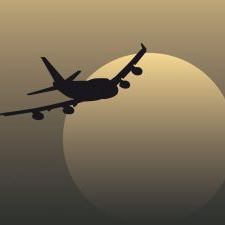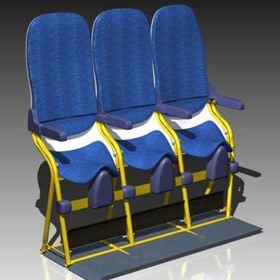Travel News
Future Flights: Skyrider Seats & the United-Continental Merger
 Will airlines begin installing the most cramped airplane seat in the world?
Will airlines begin installing the most cramped airplane seat in the world?
How will the pending Continental-United merger affect the airline industry as well as passengers?
Peter recently talked about the latest breaking travel news with Arnie Weissmann, editor in chief of Travel Weekly.
Peter Greenberg: There’s news this week about the new kind of airline scene. You know there is what we call the nosebleed seats in stadiums. I’ve come up with a new sentence: It’s the “kneebleed seat.” And it’s called the SkyRider seat. Is there anything else RyanAir won’t try?
Arnie Weissmann: Well I think RyanAir will try this. I wouldn’t be surpised if Spirit Airlines was at least checking into this. The company that is putting this out is something called Avio Interiors. It is an Italian company, and they have said that U.S airlines have expressed a strong interest in the SkyRider seat.
 It looks like a grownups’ high chair, but the seat is tilted way, way down. So you’re sort of leaning back into it; your knees are bent; your feet are on the ground. One problem I see with it—aside from the fact that you’ll be standing for however long—is that you put your carry-on beneath your seat, which means you are putting your carry-on into the person behind you’s seat. I’m sure there are going to be some issues because there’s is little enough space as it is, only 23 inches of pitch. This is going to be for people who are just out to save a buck, no matter what.
It looks like a grownups’ high chair, but the seat is tilted way, way down. So you’re sort of leaning back into it; your knees are bent; your feet are on the ground. One problem I see with it—aside from the fact that you’ll be standing for however long—is that you put your carry-on beneath your seat, which means you are putting your carry-on into the person behind you’s seat. I’m sure there are going to be some issues because there’s is little enough space as it is, only 23 inches of pitch. This is going to be for people who are just out to save a buck, no matter what.
PG: Somebody asked me about my opinion on this the other day. Other than laughing about it—and I don’t want to laugh about it because I think these guys will actually really try it. But I have no problem with them installing these seats as long with every third row there’s an orthopedic surgeon on board. It’s one thing for a one-hour short haul flight on Southwest, or Spirit, or American Air. But do you really see an airline putting it in for long haul?
AW: No, I don’t. I have no idea—these might be the most comfortable thing. They might be like La-Z Boys in the skies, but somehow I doubt it. It does look like you could do for an hour flight. You could do for maybe 90 minutes top, but I could not imagine anybody putting up with this much longer.
PG: Although, I’ve got another idea, they call them saddle seats, why don’t you have coin-operated operations, so you can ride a mechanical bull while you’re at it.
AW: Well, I think it comes with the turbulence.
Learn more: Skyrider Seats Could Mean Even Less Legroom on Planes
 PG: Unreal. Well let’s switch gears for a second. What’s your take on the shareholders approving the United-Continental deal?
PG: Unreal. Well let’s switch gears for a second. What’s your take on the shareholders approving the United-Continental deal?
AW: I heard what you said about the cultures, and I think that is a critical component. I think you were quoting some frequent- fliers saying that this is going to be a clash. I think you’re going to see it even more pronounced with the company employees. They are two very, very different airlines. The pilots unions, for instance. Labor unions could be something potentially troubling. In fact the pilot union during the initial hearings was supporting the merger. They’ve already begun to say, maybe we’re rethinking this. They don’t seem to be happy with the initial terms set out by the two airlines. And this is where the cultures are really going to come into clash. Continental has had a long history of being essentially good to their employees. Let me put it this way—they know how to motivate their employees and keep them happy. And that happiness is transferred to the passengers. United, not so much.
 PG: As I remind everyone, United is the company that last year intentionally disconnected their customer complaint phone number.
PG: As I remind everyone, United is the company that last year intentionally disconnected their customer complaint phone number.
AW: Yeah. United has suffered, perhaps more than any other legacy airline, in terms of not really knowing how to face the new paradigm. All of these things are going to be good for the big airlines. It is probably going to result in some higher prices, but what you’re seeing is less competition over all. Less competition means that pricing will go up. You’re taking care of some of the weaker airlines who are more likely to cause price disruption in the sense of prices going low. When a carrier is in trouble they’re going to have a fare sale. The fewer carriers there are in trouble, the fewer fare sales. Prices are just going to be higher.
PG: Well thanks for that uplifting good news, Arnie.
Tune into Peter Greenberg Worldwide Radio right here on PeterGreenberg.com, streaming live every Saturday 10 a.m. – 1 p.m.
Related links on PeterGreenberg.com:
- Skyrider Seats Could Mean Even Less Legroom on Planes
- United & Continental Shareholders Approve Merger, Form World’s Largest Airline
- Extra Fees Provide Big Boost to Some Airlines’ Profits
- Premium Economy Seats: Worth It?
- Do Airlines Deserve Their Bad Reputation?
- Travel Reporters Analyze Continental-United Merger’s Effects
- Effects of the Continental-United Airlines Merger on Frequent Fliers












